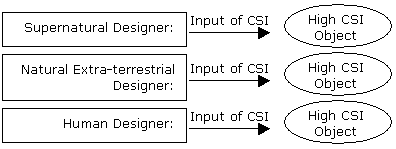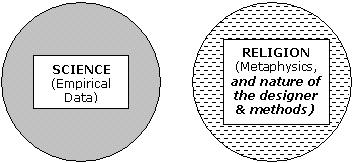| The Short Answer: No. Intelligent design theory makes no claim as to "how" the design occurred, whether it was by natural, or even supernatural causes. In fact, all you can detect through intelligent design theory is that an object was designed--not the metaphysical nature of its causation. That being said, many skeptics still say that ID has all the problems of appealing to miracles, in that it causes us to "give up" or stop searching for a "natural" cause, and that there would be no limit to its usage and threatens to relegate all explanations to non-natural causes. In fact, ID is inferred because of its positive predictions, and we only infer it when it is clearly the proper explanation for a given observation. ID is a causally adequate scientific explanation for life which is only inferred when justified. |
The Long Answer:
As seen in the diagram above, the scientific theory of intelligent design cannot name the identity of the designer, or tell you if the designed through "natural" or "miraculous" means. Intelligent design only detects the past occurrence of intelligent design in the natural world by looking for the tell-tale signs that an intelligent agent was at work. Intelligent design theory cannot tell you if the designer or the methods used to design were natural or supernatural because intelligent design works off the assumption that all designers (and the methods they use via intelligent design) in general create a certain type of information when they act. While we can detect that type of information in the natural world to infer intelligent design, finding that type of information does not give us any more information about the designer or the methods used other than that the designer intelligently designed the object in question. Consider the following diagram:

In this diagram, many types of intelligent agents could produce identical objects with high levels of CSI. Intelligent design theory can only find the object containing high levels of CSI and works backwards. From detecting ID only through complex and specified information, ID cannot necessarily tell you "how" the design occurred or whether it was natural or supernatural (or a "miracle"). While it can detect that the object was designed, it cannot discriminate what kind of designer designed the object, nor determine any specific properties about the designer, other than that it was an intelligent agent. All intelligent design theory can infer is that the object was designed. Intelligent design, as a scientific theory cannot identify the identity of the designer. Like all scientific theories, ID can only detect that which is empirically detectable via the scientific method.
Not identifying the nature of the designer or the methods used is not a cop-out nor does it stem from an unwillingness to be honest about motivations. It results solely from the pure empirical limitations of scientific investigation:
[The] only commitment [of intelligent design theory] is that the design in the world be empirically detectable…This is not a matter of being vague but rather of not pretending to [have] knowledge that we don't have. (Dembski, W. A., Eugenie Scott and the NCSE: Darwin's Predictable Defenders.)
The scientific method and empirical data are presently incapable of helping to understand if the design came through miracles or the "supernatural." Thus, the scientific theory of intelligent design simply cannot identity the nature of the designing process because it is not a question which can be addressed through the methods of science. At this point, this question can only be answered via faith, or divine revelation, and other religious "ways of knowing." Thus, assessing this question designer is essentially a religious question:

Thus, scientifically, one only can state that life was designed by an unidentified intelligence. Many may believe that the identity of the designer is the God of the Bible, who created through miracles, however these are religious claims, not scientific claims.
How do we know what we know?
Epistemological theory limits the explanatory scope of any scientific theory. It may (or may not) be possible to determine exactly "how" or "when" the designer did the designing, or whether the designer was "natural" or "supernatural." Thus intelligent design cannot appeal to miracles or the supernatural because it is impossible to detect if the cause for the design was natural or supernatural. It just depends on what is theoretically possible to empirically determine. But we don't have to be able to answer these questions to know that the object in question was indeed designed.
Practical Concerns: Is ID essentially the same as appealing to miracles?
Some people are concerned that appealing to an intelligent (though perhaps not explicitly supernatural) cause would bring the same problems as appealing to miracles because it would prevent us from seeking physical explanations. Yet there is a major difference between invoking miracles and inferring intelligent design.
Miracles are a vague and undefined cause not rooted in observations of the natural world. Intelligent design is a process that we understand through our observations of the natural world. Because we understand how it works, we know it is an adequate explanation for the origin of specified complexity, and we only infer it when we are justified in doing so because its predictions are met, and other competing hypotheses seem to clearly not be the cause at work. Here are some observations about intelligent agents that help us develop the theory of intelligent design:
|
Table 1. Predictions of Design: |
(1) High information content machine-like irreducibly complex structures will be found.
(2) Forms will be found in the fossil record that appear suddenly and without any precursors.
(3) Genes and functional parts will be re-used in different unrelated organisms.
(4) The genetic code will NOT contain much discarded genetic baggage code or functionless "junk DNA".
|
Thus, Stephen Meyer has said that we know (through empirical observations) that intelligent design is a causally adequate explanation for the existence of highly specified and complex information:
"Experience teaches that information-rich systems … invariable result from intelligent causes, not naturalistic ones. Yet origin-of-life biology has artificially limited its explanatory search to the naturalistic nodes of causation … chance and necessity. Finding the best explanation, however, requires invoking causes that have the power to produce the effect in question. When it comes to information, we know of only one such cause. For this reason, the biology of the information age now requires a new science of design.
(Stephen C. Meyer, Mere Creation, pg. 140).
"Indeed, in all cases where we know the causal origin of 'high information content,' experience has shown that intelligent design played a causal role."
(Stephen C. Meyer, DNA and Other Designs)
"Intelligent design provides a sufficient causal explanation for the origin of large amounts of information, since we have considerable experience of intelligent agents generating informational configurations of matter."
(Meyer S. C. et. al., "The Cambrian Explosion: Biology's Big Bang," in Darwinism, Design, and Public Education, edited by J. A. Campbell and S. C. Meyer (Michigan State University Press, 2003)
Based upon our understanding of how designers works, we can then make positive predictions from intelligent design theory. We only infer intelligent design when the evidence warrants it. This prevents intelligent design from becoming a "catch all" explanation. Biologist Rudolph Raff objects to design theory saying, "as the influence of the intelligent designer grows … the relationships between the phenomena and explanations becomes increasingly arbitrary … [until] one reaches a point where all biological features are 'special creations' and other explanations become unnecessary." (Raff, Rudolf A., "The creationist abuse of evo-devo." Evol Dev, 3(6): 373-374 (2001)). This is one concern that people also say will happen if we let "miracles" into science. Raff is afraid that design is a sort of "science stopper" which will prevent us from searching for natural causes. In fact, design theorist William Dembski sees Raff's arguments as typifying the reasons for the exclusion of design from science:
"What has kept design outside the scientific mainstream these last 130 years is the absence of precise methods for distinguishing intelligently caused objects from unintelligently caused ones. For design to be a fruitful scientific theory, scientists have to be sure they can reliably determine whether something is designed. Johannes Kepler, for instance, thought the craters on the moon were intelligently designed by moon dwellers. We now know the craters were formed naturally. This fear of falsely attributing something to design only to have it overturned later has prevented design from entering science proper." (Dembski, W. A., "Introduction: Mere Creation", Mere Creation Science Faith & Intelligent Design, (InterVarsity Press, 1998) pg. 16)
Dembski understands Raff's sort of concerns. What would solve Raff's problem, however, would be a rigorous criteria which allows scientists to know when to detect and infer design, and when not to. If such a method could be found, then what is best explained naturally remains explained naturally, while what is best explained through design, becomes explained through design. As Dembski subsequently says, "[w]ith precise methods for discriminating intelligently from unintelligently caused objects, scientists are now able to avoid Kepler's mistake." (Dembsk in Mere Creation) In calling what Kepler did a "mistake," Dembski shows that he doesn't want intelligent design theory to take over biology or science. Intelligent design theorists want design to be inferred where the evidence warrants--no more, and no less. The explanatory filter helps to ensure this--we exclusively infer design only if it appears to be what is produced by an intelligent agent, and we know that other causal mechanisms are incapable of producing the data. The important thing is to follow the evidence wherever it leads! That's the glory of science!
Some claim that intelligent design is a "science stopper" because it appeals to an intelligent cause. But we should only infer design where the evidence warrants. Nothing more, nothing less.


